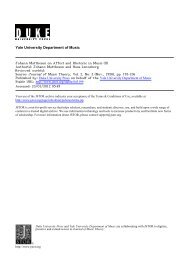Après une Lecture de Liszt: Virtuosity and ... - Free
Après une Lecture de Liszt: Virtuosity and ... - Free
Après une Lecture de Liszt: Virtuosity and ... - Free
You also want an ePaper? Increase the reach of your titles
YUMPU automatically turns print PDFs into web optimized ePapers that Google loves.
19THCENTURYMUSIC1839 (February)<strong>Liszt</strong> first refers to the projected work in hisdiary—Journal <strong>de</strong>s Zÿi—as a symphony, whichhe would complete separately in 1855–56 asEine Symphonie zu Dantes Divina Commedia:If I feel within me the strength <strong>and</strong> life, I will attempta symphonic composition based on Dante,then another on Faust—within three years—meanwhileI will make three sketches: the Triumph ofDeath (Orcagna), the Comedy of Death (Holbein),<strong>and</strong> a Fragment dantesque. 11839 (September)Marie d’Agoult’s letter to Henri Lehmann revealsthat written work on the Fragmentdantesque (for keyboard) had only just begunon 26 September 1839:Le bravo suonatore began this morning a Fragmentdantesque which is sending him to the very Devil.He is so consumed by it that he won’t go to Naplesin or<strong>de</strong>r to be able to complete this work (<strong>de</strong>stined toremain in his sketch portfolio!). 2Paper-type analysis, the fact that this sketchwas in <strong>Liszt</strong>’s h<strong>and</strong>, the spacious use of threestaves, the occasionally wayward spacing, <strong>and</strong>d’Agoult’s <strong>de</strong>monic reference (suggestive of<strong>Liszt</strong>’s opening tritones) indicate that thissketch is most likely MS I 18, No.1, 3 containingthe first twenty-four measures of the Sonata.No further notation survives prior eitherto <strong>Liszt</strong>’s private performance of the piece amonth later on 25 October 1839 at the Hôtel <strong>de</strong>l’Europe or to his public performance of it inAppendix A:Chronology of Revisions for the “Dante” SonataVienna on 5 December 1839 in the fourth morningconcert he gave there. 4The extent to which the music had beenwritten out at this stage, whether as a continuitydraft or collection of sketches, remains unknown.1840The appearance of the Prague fragment (MS1C.51), dated 11 March 1840, <strong>and</strong> the differencesbetween this fragment <strong>and</strong> the first fullMS suggest both that <strong>Liszt</strong> performed the workon his tour of Bohemia <strong>and</strong> that it may stillhave remained largely unwritten at this stage.Whatever <strong>Liszt</strong> performed in 1839–40 musthave resulted in the written exemplar of a completepiece (now lost) that was copied byGeatano Belloni as the original portions of MS I76. In a letter to d’Agoult dated 22 September1840, <strong>Liszt</strong> explains that he had been revisingseveral sections of Belloni’s manuscript. 5 Theresults of these revisions appear to be containedin MS I 76 in graphite pencil <strong>and</strong> reflect thefirst extant (notated) version of the piece, asource thought by Walker <strong>and</strong> Winklhofer nolonger to exist.MS I 18 No. 3—a more concise ending to theSonata—is also in Belloni’s h<strong>and</strong> <strong>and</strong> on thesame “Blacons” paper <strong>and</strong> seems to have beendiscar<strong>de</strong>d from MS I 76. For this reason, MS I18 No. 3 is likely to be the very first notatedconclusion to the Fragment dantesque, if weaccept that the Prague fragment from 11 March1840—also a concluding fragment—was not<strong>Liszt</strong>’s own manuscript.1“Si je me sens force et vie, je tenterai <strong>une</strong> compositionsymphonique d’après Dante, puis <strong>une</strong> autre d’après Faust—dans trois ons—d’ici-là, je ferai trois esquisse: le Triomphe<strong>de</strong> la mort (Orcagna), la Comédie <strong>de</strong> la mort (Holbein), et<strong>une</strong> Fragment dantesque” (<strong>Liszt</strong>, Journal <strong>de</strong>s Zÿi ind’Agoult, Mémories par Daniel Stern [pseud.], ed. DanielOllivier [Paris, 1927], p. 180).2Solange Joubert, Une Correspondance romantique: Madamd’Agoult, <strong>Liszt</strong>, Henri Lehmann (Paris, 1947), p. 33.3A transcription of this fragment was published in the Journalof the British <strong>Liszt</strong> Society, as “Dante fragment, S701e,”28 (2003), 34. The date given in this publication was ca.1837, which is almost certainly incorrect, for it predatesany mention of the work in <strong>Liszt</strong>’s correspon<strong>de</strong>nce by twoyears.1848–49The title page of MS I 76—“Paralopomènes à la‘Divina Comedia’”—must have been ad<strong>de</strong>d be-4Christopher Gibbs’s study of <strong>Liszt</strong>’s concert tours ofVienna in 1838 <strong>and</strong> 1839 provi<strong>de</strong>s the most <strong>de</strong>tailed pictureof <strong>Liszt</strong> at this time to date. See “‘Just Two Words:Enormous Success’: <strong>Liszt</strong>’s 1838 Vienna Concerts,” in <strong>Liszt</strong><strong>and</strong> His World, pp. 167–230.5“Je vais bien – j’ai corrigé ces jours <strong>de</strong>rniers quelquesparties du fragment Dantesque,” <strong>Liszt</strong> to Marie d’Agoult,22 September 1840, Ipswich, in Correspondance / Franz<strong>Liszt</strong>, Marie d’Agoult (Paris: Fayard, 2001), p. 645.92



